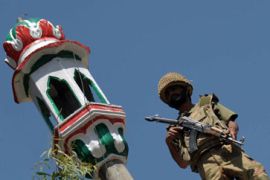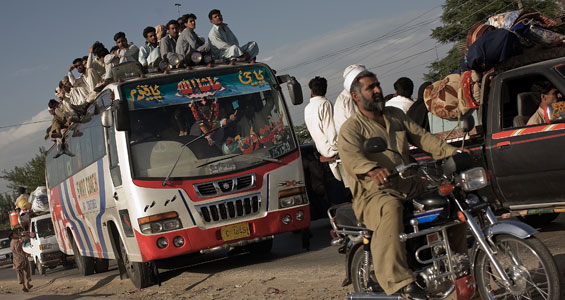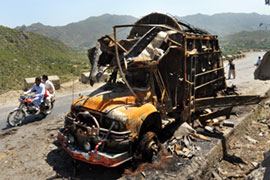The fight for northwest Pakistan
Kamal Hyder reports from Peshawar as people fleeing Swat arrive in the city.

 |
| The hundreds of thousands of people fleeing the conflict are helping to form a picture of the dire situation inside Swat, Dir and Buner [Gallo/Getty] |
The testimonies of the hundreds of thousands of people fleeing from the Swat valley enable us to draw up a picture the fierce encounters between government forces and pro-Taliban fighters.
The claims of high casualties among the fighters cannot be confirmed, but what can be established from the accounts of officials and witnesses is that the situation in the region is serious.
From Mardan the road to Swat travels through Malakand, perched high in the mountains and touching the edges of the plains.
Here Winston Churchill, the second world war British prime minister, was pinned down during his earlier army career as angry tribesmen exchanged fire with British forces marching on Swat.
But today’s war is very different and it is a different army that is battling the mysterious young men who call themselves Taliban but do not have the credentials to prove they have had any religious education.
Outside support
Most are aged between 15 to 20 years old and their number is thought to include Afghans, who some Pakistani officials now allege are supported from outside the country.
Pakistan’s foreign minister has said that weapons are arriving the North West Frontier Province from across the border.
| In video |
|
|
Others fighters are hardened criminals, some wanted by the authorities for murder, extortion or kidnappings for ransom.
Armed with sniper rifles, rocket-propelled grenades, assault rifles, light machine guns and even mortars, about 400 to 500 fighters control the small town of Kambar, which straddles the Mingora-Malakand highway.
Typically they emerge in groups of five or ten and while previously they had only appeared with their faces covered, many now are more brazen.
Al Jazeera discovered that even while the peace deal with the government was on track, they were planting improvised explosive devices on the main highway in and out of Swat.
Local traders were alerted by the unusually bullish sales of pressure cookers, the favorite utensil for making such devices.
A source told us that holes were dug in the tarmac along the road and the explosives placed in them before they were covered with concrete.
He said that his vehicle was parked over such a device when a convoy he was travelling in was parked on the road.
“They could have blown us to pieces if they wanted but I presume they have put these for the army,” he told Al Jazeera.
Intense activity
Less than a few minutes flight from the Swat valley, the skies above Peshawar, the provincial capital of the North West Frontier Province buzz with intense activity.
 |
| Pakistani troops are battling fighters armed with rifles, grenades and mortars [AFP] |
The army’s American-supplied Cobra helicopter gunships rattle the windowpanes of the city below as they carry their heavy payload of ordnance, typically Tow anti-tank missiles to bust fortifications and high-powered cannons that pulverise the fighters’ hideouts.
With the roads in Swat mined, the military is relying on its helicopters to ferry in supplies and take out the wounded in what appears likely to be a protracted conflict.
The population of the Dir, Buner and Swat agree and many hundreds of thousands of them have joined the exodus to internally displaced people’s camps around the major cities.
As fears of a humanitarian disaster have risen, the International Red Cross set up a hospital for weapons-related wounds and their local representative in the province tells us increasing numbers of wounded are arriving in Peshawar.
But even here in the city which functions as the heart and business centre of the valley people feel far from safety as the sound of small arms fire, punctuated by exploding artillery and mortar shells, keeps the people awake.

 Pakistan pledges to continue Swat offensive
Pakistan pledges to continue Swat offensive